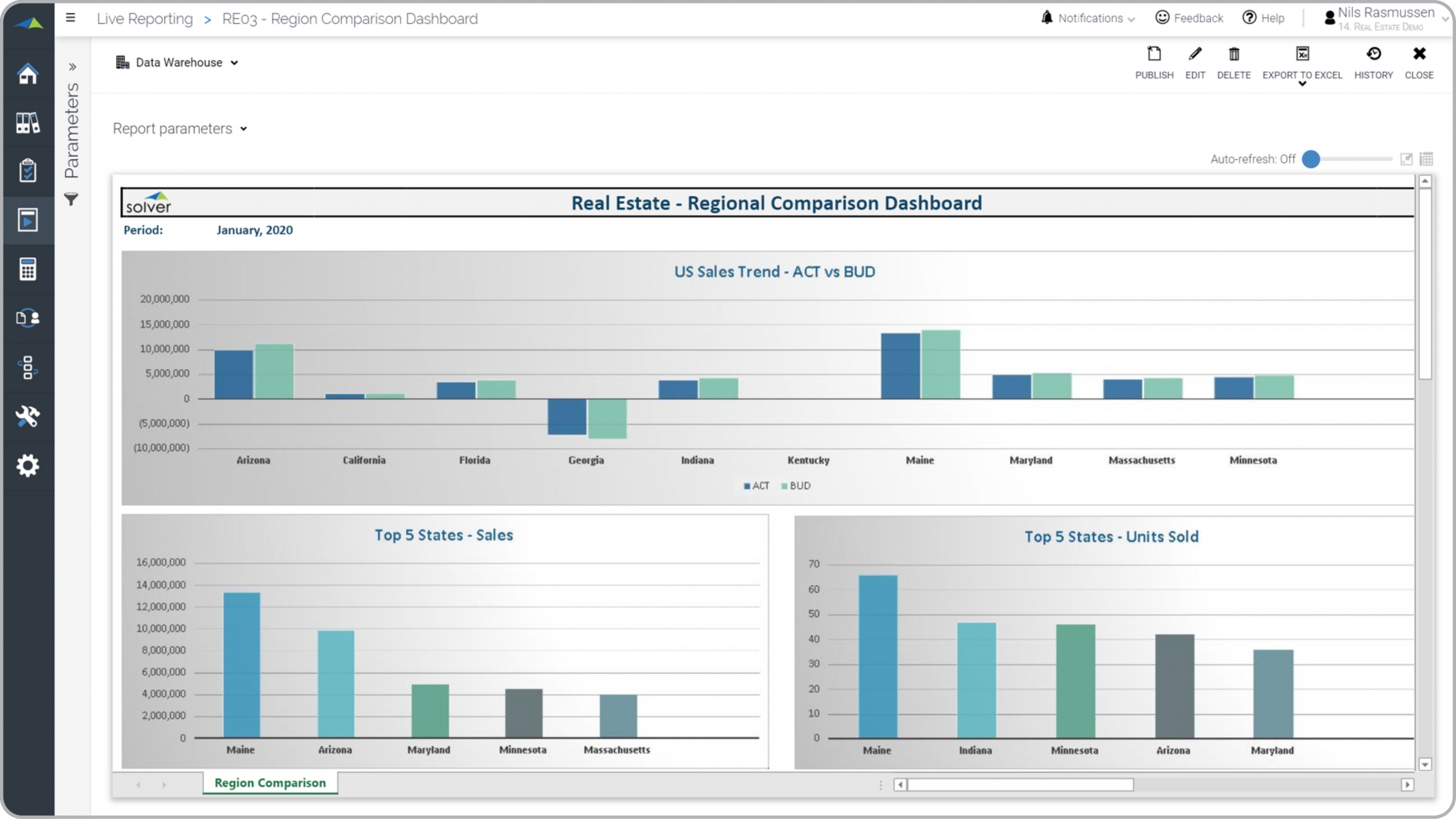Regional Sales Dashboard for Real Estate Companies
What is a
Regional Sales Dashboard
? Regional Sales Dashboards are considered territory benchmarking tools and are used by executives and sales leaders to compare performance across geographical regions. Some of the main functionality in this type of dashboard is that it provides monthly sales analysis across three perspectives, including: 1) Monthly sales for all territories, 2) Top five regions by sales amount, and 3) Top five regions by unit sales. The dashboard can be refreshed by changing the period parameter. You find an example of this type of dashboard below.
Purpose of
Regional Sales Dashboards Real Estate companies use Regional Sales Dashboards to give managers a clear view of actual to budget and comparative sales figures across regions and/or territories. When used as part of good business practices in Sales and Financial Planning and Analysis (FP&A) departments, a company can improve its strategic decisions and improve sales, and it can reduce the chances that managers don't make timely decisions for underperforming territories.
Example of a
Regional Sales Dashboard Here is an example of a Regional Sales Dashboard with variance analysis and territory comparisons. [caption id="" align="alignnone" width="2560"]
 Example of a Regional Sales Dashboard for Real Estate Companies[/caption] You can find hundreds of additional examples
here
Who Uses This Type of
Dashboard
? The typical users of this type of dashboard are: Executives, CFOs, regional sales managers, budget managers and agents.
Other Reports Often Used in Conjunction with
Regional Sales Dashboards Progressive Sales and Financial Planning and Analysis (FP&A) departments sometimes use several different Regional Sales Dashboards, along with sales reports, KPI dashboards, financial statements, annual budget models, corporate forecasts and other management and control tools.
Where Does the Data for Analysis Originate From? The Actual (historical transactions) data typically comes from enterprise resource planning (ERP) systems like: Microsoft Dynamics 365 (D365) Finance, Microsoft Dynamics 365 Business Central (D365 BC), Microsoft Dynamics AX, Microsoft Dynamics NAV, Microsoft Dynamics GP, Microsoft Dynamics SL, Sage Intacct, Sage 100, Sage 300, Sage 500, Sage X3, SAP Business One, SAP ByDesign, Acumatica, Netsuite and others. In analyses where budgets or forecasts are used, the planning data most often originates from in-house Excel spreadsheet models or from professional corporate performance management (CPM/EPM) solutions.
What Tools are Typically used for Reporting, Planning and Dashboards? Examples of business software used with the data and ERPs mentioned above are:
Example of a Regional Sales Dashboard for Real Estate Companies[/caption] You can find hundreds of additional examples
here
Who Uses This Type of
Dashboard
? The typical users of this type of dashboard are: Executives, CFOs, regional sales managers, budget managers and agents.
Other Reports Often Used in Conjunction with
Regional Sales Dashboards Progressive Sales and Financial Planning and Analysis (FP&A) departments sometimes use several different Regional Sales Dashboards, along with sales reports, KPI dashboards, financial statements, annual budget models, corporate forecasts and other management and control tools.
Where Does the Data for Analysis Originate From? The Actual (historical transactions) data typically comes from enterprise resource planning (ERP) systems like: Microsoft Dynamics 365 (D365) Finance, Microsoft Dynamics 365 Business Central (D365 BC), Microsoft Dynamics AX, Microsoft Dynamics NAV, Microsoft Dynamics GP, Microsoft Dynamics SL, Sage Intacct, Sage 100, Sage 300, Sage 500, Sage X3, SAP Business One, SAP ByDesign, Acumatica, Netsuite and others. In analyses where budgets or forecasts are used, the planning data most often originates from in-house Excel spreadsheet models or from professional corporate performance management (CPM/EPM) solutions.
What Tools are Typically used for Reporting, Planning and Dashboards? Examples of business software used with the data and ERPs mentioned above are:
- Native ERP report writers and query tools
- Spreadsheets (for example Microsoft Excel)
- Corporate Performance Management (CPM) tools (for example Solver)
- Dashboards (for example Microsoft Power BI and Tableau)
Corporate Performance Management (CPM) Cloud Solutions and More Examples
June 29, 2021
TAGS:
Reporting,
Solver,
report writer,
Microsoft,
template,
practice,
Acumatica,
Netsuite,
Finance,
planning,
GP,
dashboard,
sales dashboard,
Business Central,
state,
excel,
ax,
forecast,
Budget,
Dynamics 365,
budgeting,
region,
Cloud,
Software,
Tableau,
SAP,
example,
best,
Sage,
BC,
D365,
NAV,
Intacct,
Real Estate,
CPM,
report,
SL,
Management,
dynamics,
sales,
Power BI,
property,
regional sales,
regional comparison

